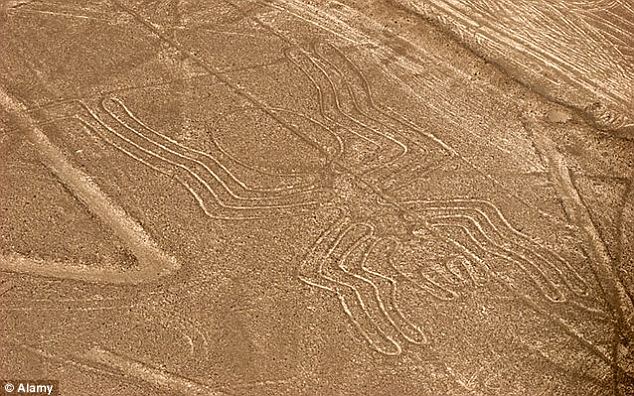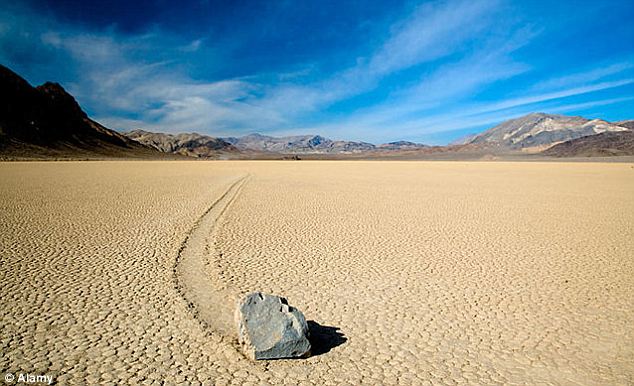
|
|||
10 bizarre phenomena that still have scientists baffled - Top Unexplained Mysteries
Source : www.science-uncovered.com
By Hayley Birch, Science Uncovered Scientists have spent centuries uncovering the many mysteries of the natural world, yet some phenomena still baffle even the sharpest of scientific minds. From strange lights in the sky following earthquakes to rocks that spontaneously glide across the ground, these naturally-occurring events from around the world seem to have no purpose or meaning. Science Uncovered‘s Hayley Birch has compiled a list of the top 10 most strange, cryptic and incredible naturally-occurring events from around the world. For mystery, controversy and epic scale, nothing beats earthquake lights - the unexplained illuminations in the sky that can accompany a seismic shudder. The various theories include heat caused by friction, radon gas and piezoelectricity - an electric charge accumulating in quartz rocks as tectonic plates move 1. EARTHQUAKE LIGHTS: Ethereal lights that appear in the sky before and during a quake 
For mystery, controversy and epic scale, nothing beats earthquake lights – the unexplained illuminations in the sky that can accompany a seismic shudder. For mystery, controversy and epic scale, nothing beats earthquake lights – the unexplained illuminations in the sky that can accompany a seismic shudder. The various theories include heat caused by friction, radon gas and piezoelectricity – an electric charge accumulating in quartz rocks as tectonic plates move 
The mystery: what causes them? The controversy: do they even exist? And the epic status? Well, it’s like an earthquake and a lightning storm all rolled into one. It’s beyond Biblical. The original article appears in issue 2 of the brand new science magazine, Science Uncovered, on sale now Italian physicist Cristiano Ferugia assembled a complete account of earthquake light reports dating back to 2000BC. For a long time, however, geoscientists remained sceptical about the strange phenomenon. It wasn’t until 1966 that hard evidence emerged, in the form of photos from the Matsushiro earthquake in Japan. Now, of course, you have only to head to the internet to come across hundreds of pages full of earthquake light photos, many of dubious authenticity. But the lights appear in so many different colours and forms – from red to white to blue, and in globes, flickers and glows – that it’s difficult to spot a fake. The various theories include heat caused by friction, radon gas and piezoelectricity – an electric charge accumulating in quartz rocks as tectonic plates move. In 2003, NASA physicist Dr Friedemann Freund carried out lab experiments, which suggested that earthquake lights are caused by electrical activity in rocks. He said shockwaves from earthquakes can change the electrical properties of silicon and oxygen-containing minerals, allowing them to transmit currents and emit light. But Professor David Brumbaugh, at the Arizona Earthquake Information Center in Flagstaff, Arizona, thinks the theory can be considered only a ‘possible explanation’ at best. ‘Although Freund’s theory seems promising, the answer may be a bit more complicated,’ he said. Brumbaugh, however, admits he’s not aware of any new research that would be as useful as Freund’s. 2. THE NAZCA LINES: Vast shapes drawn in the Peruvian sand by an ancient population – but no one knows why 
Covering a 450km expanse of coastal desert, the Nazca Lines are oversized artworks etched into the Peruvian plains, pictured. They are thought to have been created by the Nazca people over a 1,000-year period between 500BC and 500AD, but no one knows why Covering a 450km2 expanse of coastal desert, the Nazca Lines are oversized artworks etched into the Peruvian plains. Including large geometric designs as well as pictures of animals, plants and rarer human-like figures, they are visible from the air as giant line drawings. They are thought to have been created by the Nazca people over a 1,000-year period between 500BC and 500AD, but no one knows why. Despite World Heritage status, the Peruvian authorities have trouble protecting the Lines from squatters. According to Peruvian law, which protects the landless, squatters only have to stay for a single day in order to be able to stake a claim. Last year, reports emerged of Peruvians raising pigs on the artworks. In their view, the site is simply an expanse of wasted space in a region with a rapidly growing poor population. Meanwhile, archaeologists are trying to study the Lines before they are destroyed. Early claims that the designs formed part of an astronomical calendar have been discredited and, since 1997, researchers working as part of a Peruvian-German collaboration have turned their attention to the history and culture of the people who created them – how they lived and what happened to them. In 2012, Yamagata University, in Japan, announced that it would open a research centre at the site as part of a 15-year project to study more than 1,000 drawings. 3. INCREDIBLE BUTTERFLY NAVIGATION: Monarch butterflies find their way thousands of miles to specific mountains 
Millions of monarch butterflies, pictured, migrate 2,000 miles every year. In 1976, zoologists found them at the top of the ‘Mountain of Butterflies’ in Mexico. While scientists know the monarchs target 12 to 15 Mexican mountain sites, they don’t know how they navigate there Each year, millions of North American monarch butterflies migrate 2,000 miles south for winter. For years, no one knew where they ended up. Then, in the 1950s, Norah Urquhart and her husband Fred, a zoologist, began tagging and tracking the creatures. In 1976, tipped off by a local woodcutter, they climbed to the top of the ‘Mountain of Butterflies’. All the butterflies in North America, it seemed, were in a mountain forest in Mexico. That’s not where the story ends. While we know the monarchs target just 12 to 15 Mexican mountain sites, we don’t know how they navigate there. Studies suggest they use the position of the Sun to fly south, adjusting for the time of day through circadian clocks in their antennae. But the Sun only gives them a general direction. What guides them towards the Michoacan mountains? ‘They are funnelled in, probably by landmarks as they reach the overwintering site,’ said Professor Steven Reppert, a monarch expert at the University of Massachusetts. ‘But how they home in is still a mystery.’ Landmarks such as the Gulf of Mexico couldn’t provide enough information to take butterflies all the way, so they must use other short-range navigation systems. One theory is that a geomagnetic force attracts them, although, says Reppert, ‘that’s never really panned out’. Scientists only recently acquired some of the genetic tools needed to probe the details of their navigation systems. Now they have a full genetic code, they are starting to knock out genes to see how this affects the animals’ sense of direction. 4. BALL LIGHTNING: Spheres of light that appear during or after a thunderstorm. 
The phenomenon of ball lightning has generally been described as being a luminous sphere that appears during or after a thunderstorm. Some theories suggest ball lightning, pictured, is a plasma, others that it is the result of a chemiluminescent process – light that occurs due to a chemical reaction Nikola Tesla, the physicist who invented AC power, supposedly created ball lightning in his lab. He wrote in 1904 that he ‘never saw fireballs, but…succeeded in determining their formation and producing them artificially’. It was a surprising claim then, and is perhaps even more surprising now given that modern scientists have struggled to reproduce the results. What’s more, many in the scientific community remain sceptical about the existence of ball lightning, full stop. However, eye witness reports of naturally occurring ball lightning were made as far back as the era of the ancient Greeks. In modern times, the phenomenon of ball lightning has generally been described as being a luminous sphere that appears during or after a thunderstorm. There have also been reports of lightning balls passing through window panes and down chimneys. Some theories suggest ball lightning is a plasma, others that it is the result of a chemiluminescent process – light that occurs due to a chemical reaction. In August 2013, researchers at the US Air Force Academy in Colorado made and photographed bright white plasmoid balls in their lab. The balls were generated from high-power electric sparks, discharged by electrodes partly submerged in electrolyte solutions. Even the researchers couldn’t be sure that what they had created was ball lightning. Therefore, they refer to the phenomenon as “ball-lightning-like atmospheric pressure plasmoids”. Slightly less exciting than Tesla’s fireballs, perhaps, but it’s certainly the closest that anyone has come to repeating his work. 5. WANDERING ROCKS OF DEATH VALLEY: Stones that slide across the ground under some kind of mysterious force 
At Racetrack Playa in the Death Valley, California, pictured, heavy rocks appear to move across the floor while no one is looking. Scientists believe the movement may be caused by the ice stuck to the bottom of the stones, which are then moved in the wind. However, no-one has caught the stones in the act At Racetrack Playa in the Death Valley National Park, California, strange forces are at work. Forces capable of pushing heavy rocks across the flat surface of a dried-out lake while no one is looking. Scientists have scratched their heads over the trails left by these sliding stones since early in the 20th Century. In the 1960s, Californian geologists started a rock monitoring programme. They tracked 30 stones, weighing up to 25kg, 28 of which moved during a seven-year period – some more than 200m. Analysis of the stones’ trails suggested speeds of 1m per second. In most cases, the stones travelled in winter. In the decades that followed, theories about ice and wind gained support. Others involved algal slime and seismic vibrations. So what’s happening? Are the stones sliding around in bad weather? ‘We think so,’ says Dr Gunther Kletetschka, of the Academy of Science of the Czech Republic and Charles University in Prague, who led a 2013 study on the stones. His team’s research describes what happens when water on the Playa surface freezes. According to their theory, ice stuck to the stones remains frozen longer than the surrounding ice – because rock conducts heat away faster. This reduces the force between the rocks and the Playa surface, so they can be pushed by the wind. No one has yet caught the stones in the act, and they’ve been strangely still of late. Kletetschka thinks this is due to water levels. ‘The reason for stones not moving recently is the presence of an artificial trench, draining the excess water from the Playa,’ he says. 6. THE ANNOYING LOW FREQUENCY HUM: An unidentified drone that only some people are able to hear 
An unidentified hum is a low-frequency noise that’s been heard from Bristol to Bondi. Scientists have attributed this drone to tinnitus, distant waves crashing, pictured, industrial noise and singing sand dunes. In 2006, one New Zealand scientist claimed to have recorded the sound It sounds like the title of a dodgy horror film about killer bees. The Hum is actually the name given to an irritating low-frequency noise that’s been bothering the locals everywhere from Bristol to Bondi. Here’s the thing, though – not everybody can hear it. Less than one in 20 people can. Which is pretty annoying if you’re that one in 20 and nobody will believe you. Last year, residents of Beaufort in County Kerry, Ireland, begged the local council to deal with a persistent humming noise that had begun the previous April. One resident told the Irish Examiner, ‘Not everybody in the parish has heard the noise, but just because they can’t hear it doesn’t mean it isn’t there.’ The council tried switching off water pumps that residents blamed for The Hum, but it made no difference. Elsewhere, scientists have attributed The Hum to tinnitus, distant waves crashing, industrial noise and singing sand dunes. In 2006, one New Zealand scientist claimed to have recorded the sound. 7. REAPPEARING CICADAS: Insects that suddenly wake up after nearly 20 years to find a mate 
In 2013, cicadas emerged from the ground after not being seen since 1996. Scientists have no idea how they were knew when it was the right time to leave the ground The adolescents emerge from their dark little homes, after a 17-year slumber. They arrive noisy, in a frenzied search for a partner. No, they’re not teenagers on the way to their school prom. They’re cicadas.Periodical cicadas are, for the most part, quiet and solitary, spending their days burrowing underground. They’re long-lived for insects and don’t mature until their 17th year. In the summer of this year, however, something happens. En masse, they rise from the ground as a plague of lust, in search of mates.
8. RAINING SPRATS AND DOGS Raining sprats and frogs: When wildlife falls from the skies like rain 
Scientists are sceptical about animal rain. Odzaci, in Serbia, has supposedly been pelted by frogs, and perch have fallen on Lajamanu, Australia. After tadpoles rained on the Japanese cities of Nanao and Hakusan in 2009, it was suggested birds dropped them but this has never been proved In January 1917, biologist Waldo McAtee presented a paper to the Biological Society of Washington, rather disturbingly entitled Showers of Organic Matter. The paper’s contents list reads like a recipe for a witch’s potion, covering everything from hay and flesh to ants and toads. In the eight-page report, he dispenses with more spurious claims, while seeming to accept salamander larvae raining down on Minnesota, and showers of sprats, whitings and herrings in the UK. Odzaci, in Serbia, has supposedly been pelted by frogs, and perch have fallen on Lajamanu, Australia. After tadpoles rained on the Japanese cities of Nanao and Hakusan in 2009, it was suggested birds dropped them. If this were true, though, the tadpoles should have been more widely distributed. Scientists are sceptical about animal rain, but one simple explanation by a French physicist in the 19th century is that high winds pick up and drop the animals. A slightly more complex theory involves a ‘tornadic waterspout’ – a tornado that crosses a pond or lake, sucking in aquatic life as it goes. Fish might be pulled in by the vortex and deposited wherever the waterspout runs out of steam. However, while there seems to be tentative agreement that this would be possible, there are no scientific studies that confirm it. McAtee was more concerned with how these chance events might serve population dispersal. ‘Fishes are fated to fall where they cannot survive,’ he wrote. ‘Their inability to live long out of water strictly limits the possibilities of their deriving advantage by wind transport.’ 9. THE GREAT BALLS OF COSTA RICA: Giant stone spheres whose purpose is unfathomable 
The great balls of Costa Rica, pictured, were found in the 1930s. Some are as large as two metres in diameter. Now dated to between 600 and 1000 AD, the balls are known locally as Las Bolas. Yet, there are no written records of the culture of the people who created them Why the people of pre-Spanish colonisation Costa Rica decided to carve hundreds of giant balls out of stone is as much a mystery today as it was when the balls were discovered. The Great Balls of Costa Rica were found by the United Fruit Company in the 1930s, when it was clearing land to turn into banana plantations. Some are as large as two metres in diameter. Now dated to between 600 and 1000 AD, the balls are known locally as Las Bolas. What makes solving the mystery particularly challenging is there are no written records of the culture of the people who created them. Spanish settlers ensured the indigenous population’s cultural heritage was wiped out. One of the first investigations of the stones was published in 1943 by archaeologist Doris Stone, who mapped their distribution. University of Kansas anthropologist Professor John Hoopes has dismissed most theories about the stones’ purpose – in particular those concerning lost cities and space ships. In 2012, he travelled to Costa Rica to evaluate their potential for World Heritage Status. A decision has not yet been made. 10. IMPOSSIBLE FOSSILS: The remains of long-dead creatures that crop up in the wrong place 
Fossilis uncovered in geographical regions and archaeological time zones they don’t belong to have fuelled creationist arguments. Some of these have yielded new information about our ancestry. Others have been revealed as fakes. Recently, a human skull unearthed in Sussex was found to be a forgery Since the theory of evolution emerged in the 19th century, scientists have been faced with some surprising discoveries that have seemed to defy it. Perhaps the most puzzling have been fossils – and, in particular, human fossils – turning up in the ‘wrong’ place. Fossilised fingers and footprints uncovered in geographical regions and archaeological time zones they don’t belong to have fuelled creationist arguments and forced scientists to defend Charles Darwin’s widely accepted theory. Some of these discoveries may yield new information about our ancestry. Others will undoubtedly be revealed as honest mistakes or, at worst, fakes. In one of the most famous examples of a fossil forgery, an apparently human skull was unearthed in the Sussex hamlet of Piltdown in the UK. From a series of finds starting in 1911, amateur archaeologist Charles Dawson pieced together fragments that were considered to be from a 500,000-year-old, big-brained human, dubbed Piltdown Man. At first, Piltdown Man’s oversized head led scientists to believe he was ‘the missing link’ between humans and apes. But by the 1950s, it had become clear that Piltdown Man was a hoax. His ape-like jaw was not just ape-like – it once belonged to an ape and had been combined with a diseased human skull that radiocarbon dating revealed was less than 1,000 years old. Chemical analysis also showed that the skull was probably stained to make it look older. The original article appears in issue two of the brand new science magazine, Science Uncovered, on sale now. To find out more about the magazine, visit www.science-uncovered.com. comments powered by Disqus Submit News/Videos/Links | Discuss article | Article Link | More Unsolved and Unexplained Mysteries |
More can be addded on request. Direct your requests at vinit@theunexplainedmysteries.com
